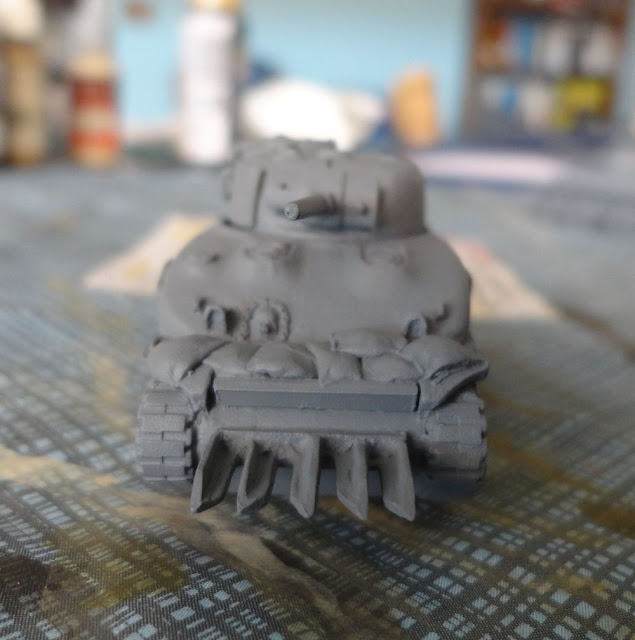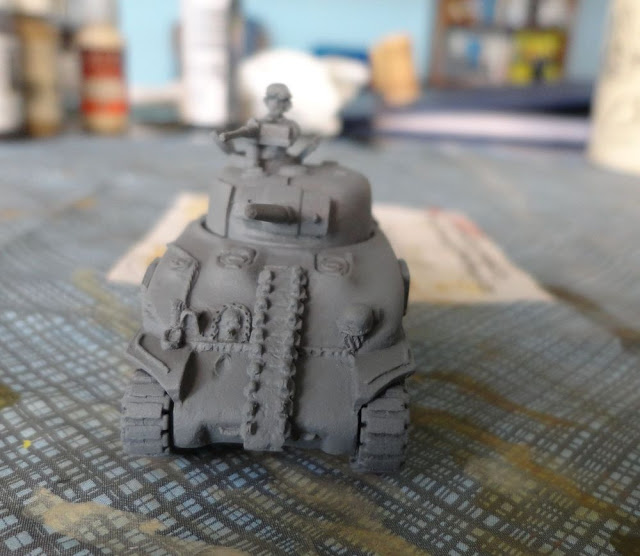Colori di base utilizzati e tecnica di modulazione
Basic colors used and modulation tecnique
I colori che ho utilizzato per il primo Sherman, e che userò anche per gli altri sono di due ditte: Tamiya e Vallejo. I Tamiya sono stati diluiti con il loro diluente specifico, mentre i Vallejo con l'alcol bianco per pavimenti. Quest'ultimo, contenendo fino al 30% di alcol isopropilico, è un diluente poco aggressivo, ottimo per gli acrilici.
The colors I used for the first Sherman, and that I will use for the others are from two companies: Tamiya and Vallejo. The Tamiya were diluted with their specific thinner, while Vallejo with white alcohol for floors. The latter, containing up to 30% of isopropyl alcohol, is a little aggressive diluent, great for acrylics.
Tamiya:
XF-62 Olive drab
XF-69 NATO black
Vallejo:
72067 Cayman green (Game color)
70915 Deep yellow (Model color)
70950 Black (Model color)
Il procedimento che ho seguito durante la pittura ad aerografo è il seguente.
The procedure that I followed during the airbrush painting is the following.
1) Innanzitutto, dopo aver primerato di grigio il modello, ho dato diverse mani leggere di Olive drab diluito al 50% in volume col X-20A, quando ho visto che la copertura era omogenea ho insistito sulle aree più basse di scafo, sovrastruttura e torretta del carro; in modo che si creasse una sfumatura scura iniziale diretta verso il basso.
First, after primering grey model, I gave several light coats of Olive drab diluted 50% by volume with the X-20A, when I saw that the coverage was homogeneous I insisted on the lower areas of the hull, superstructure and turret of the tank; so that it would create a direct initial dark shade down.
2) Successivamente ho aspettato circa 12 ore, poi ho iniziato con la passata di Cayman green; questo è stato diluito al 60% in volume con l'alcol bianco. La diluizione in questo e nei passaggi seguenti è molto importante, il pigmento deve essere molto diluito in modo che una volta seccato non risulti coprente ma lasci intravedere il colore sottostante e crei una fusione gradevole e non uno stacco brusco. Il principio è lo stesso delle velature date a pennello, ma è molto più veloce da eseguire.
After that I waited about 12 hours, then I started with a passage of Cayman green; this was diluted to 60% by volume with the white alcohol. The dilution in this and the following steps is very important, the pigment must be very diluted so that once dried do not result as a topcoat but let glimpse the underlying color and create a pleasant fusion and not a sharp contrast. The principle is the same of the glazes with a brush, but it is much faster to execute.
Vi allego alcuni suggerimenti frutto della mia esperienza con l'aerografo:
I am attaching some suggestions fruit of my experience with the airbrush:
+ Mi raccomando diluite sempre in maniera adeguata i colori, soprattutto quando usate l'aerografo; la maggior parte dei problemi si creano proprio per un'errata diluizione. Colori troppo densi e l'aerografo continuerà a bloccarsi o addirittura non inizierà neanche a spruzzare, troppo liquidi e non avrete il tempo di spruzzare, che già il modello gronderà di colore che gocciolerà ovunque prima di asciugare; macchiando la superficie.
I always recommend to thin down colors adequately, especially when using an airbrush; most of the problems are created just to incorrect dilution. Too dense colors and airbrush continue to jam or even not even begin to spray, too liquid and will not have time to spray, which already the model drips of color that will drizzle everywhere before drying; staining the surface.
+ Non aerografate in giornate umide, buie e fredde se non disponete di un ambiente controllato e indipendente dall'esterno. Per dire, io dipingo in veranda, non è un esempio di ambiente controllato e indipendente da quello esterno.
Don't airbrush in humid, dark and cold days if you do not have a controlled environment independent from the outside. To say, I paint on the porch, this is not an example of environment controlled and independent from the external.
+ Per diluire i colori acrilici non usate MAI l'acqua, cercate sempre di usare alcol o un liquido con un calore latente di evaporazione molto più basso di quello dell'acqua. Il calore latente indica l'energia (calore) che deve essere assorbito dal liquido per evaporare, più è alto più il liquido ha difficoltà a vaporizzare e quindi ad asciugarsi.
To dilute acrylics NEVER use the water, always try to use alcohol or a liquid with a latent heat of evaporation much lower than that of water. The latent heat indicates the energy (heat) that must be absorbed by the liquid to evaporate, the higher the more the liquid has difficulty to vaporize, and then to dry.
+ Se volete vivere a lungo usate una mascherina per non inalare schifezze, cercate di avere aria di ricambio. Proteggete la mano con cui tenete il modello o il suo supporto con un guanto, il sudore lascia segni indelebili sulla pittura appena seccata; inoltre eviterete di avere le mani verdi dopo la prima passata.
If you want to live long use a mask to prevent breathing crap, try to have replacement air. Protect the hands with which you hold the model or its stand with a glove , the sweat leaves indelible marks on the painting soon dried; also you avoid to have green hands after the first pass.
Tornando al procedimento, ho spruzzato il Cayman green nei punti più in luce del modello, aiutandomi con dei pezzi di cartone a creare delle maschere con cui coprire le parti che volevo rimanessero scure. In questo modo si vengono a creare delle zone di contrasto che danno tridimensionalità al colore altrimenti piatto.
Returning to the procedure, I sprayed the Cayman green on more light points, helping me with pieces of cardboard to create masks with which to cover the parts that I wanted to remain dark. In this way we are created the areas of contrast that give three dimensionality to the otherwise flat color.
3) Terminata la seconda mano aspettate un'altra mezza giornata. Poi mettete nell'aerografo un mix di 10% Deep Yellow, 30% Cayman green e 60% di alcol bianco e, sempre usando le maschere e aggiustando la posizione del modello, iniziate la terza mano. Questa volta la mano dovrà essere più sottile della precedente e dovrà essere data solo sul tetto della torre e dello scafo, eventualmente su qualche bordo acuminato o punto che volete risaltare. Quando avete finito, prima di riporre i colori, usando lo stesso mix col pennello; evidenziate i particolari troppo piccoli da fare a spruzzo. Eventualmente aggiungete altro giallo in piccole dosi per aggiungere contrasto.
After the second coat wait another half day. Then place in the airbrush a mix of Deep Yellow 10%, Cayman green 30% and White alcool 60% and ,always using masks and by adjusting the position of the model, started the third coat. This time the passage has to be thinner than the previous one and will be given only on the roof of the turret and the hull, possibly on some sharp edge or point that You want to emphasize. When you finished, before putting away the colors, using the same mix with the brush; highlight the details too small to do by spraying. Possibly add more yellow in small amounts to add contrast.
4) Per la mimetica aspettate nuovamente che il colore secchi adeguatamente, mascherate il mezzo con il patafix lasciando delle chiazze non coperte, queste diventeranno la nostra mimetica. Abbiate premura che il patatfix crei dei bordi definiti e tondeggianti. Per tirare bene il patafix aiutatevi con uno stuzzicadenti o un pennello girato al contrario.
Caricate l'aerografo con il Black diluito al 60% in volume con l'alcol bianco e spruzzate la mistura nei punti non coperti dal patafix, facendo attenzione a definire bene i bordi delle chiazze mimetiche.
For the mimetic wait again that the color properly dried, masked the vehicle by patafix leaving patches of uncovered that will become our camouflage. Strive to the patatfix creates defined and rounded edges. To pull well patafix help yourself with a toothpick or brush turned upside down. Loaded the airbrus with the Black diluted to 60% by volume with the white alcohol spray the mixture on the points not covered by patafix, making sure to define the edges of the camouflage Patches.
No images for now
5) Come al solito aspettate l'asciugatura, non rimuovete il patafix. A colore secco ricaricate l'aerografo con questo mix Black 30%, NATO black 10% e 60% in volume alcol bianco. Usate questo colore più chiaro per mettere in risalto angoli e punti in luce della mimetica. Una volta terminato questo passaggio con il pennello passate sui particolari minuti, esattamente come avevate fatto per il verde. Potete aggiungere un pochino di Nato black per far risaltare ancora di più i particolari a patto che la mistura non diventi troppo grigia.
As usual wait for it to dry, do not remove the patafix. As the color dried reload the airbrush with this mix Black 30%, NATO black 10% and 60% by volume of White alcohol . Use this lighter color to highlight corners and points in light. Once this step with the brush passed on minute details, exactly as you did for the green. You can add a little of NATO black to stand out even more details as long as the mixture does not become too grey.
No images for now
FINITO, i colori basici sono stati dati e avete ottenuto una modulazione decente su tutto il mezzo, il prossimo passaggio sarà l'invecchiamento usando colori ad olio, acrilici e pigmenti.
FINISHED, the basic colors have been given and you have got a decent modulation on whole vehicle, the next step will be the wheathering using oil paints, acrylics and pigments.








































